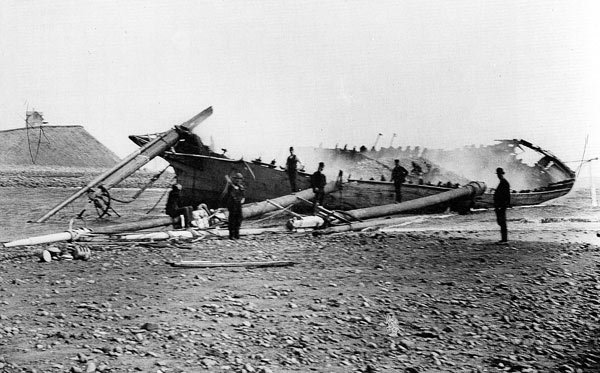B A C K T H E N
A Long, Slow Burn

September 1893. Kennebunk, Parson’s Beach, at the mouth of the Mousam River. Great Hill is in the background. The Rockland lime coaster Carrie G. Crosby smolders.
Schooner Carrie G. Crosby, Capt. Wm. R. Kalloch, of and from this port for Salem, with lime, went ashore, Wednesday morning, on Kennebunk beach. A dispatch says that she is on fire and will be a total loss. She was being stripped. The vessel is owned by A. F. Crockett Co. and others, and that firm own the cargo. She was a vessel of 58 tons, built in Chelsea, Mass., in 1869. We understand there is very little insurance on her; the lime was insured. –The Rockland Opinion, Sept. 22, 1893.
We can only speculate on why the Crosby went aground. No gale was reported, and the old schooner certainly knew the path between Rockland and Cape Ann. It is very likely that a sudden leak ignited her cargo—water and lime produced fire—and she was intentionally beached. In one year’s time, ending in 1892, Cobb, Wight & Co., Rockland’s biggest lime manufacturer, lost seven lime schooners, six of them by fire. The ideal lime coaster was said to be old, cheap, and tight. Unfortunately, the first two qualifications were easier met than was the third. Old “fishermen”—fishing schooners—were preferred, because the shape of their hull placed the lime, stowed on a platform, above the bilge water. In 1889, a Rockland captain bought a 100-ton schooner that had been built at Barnstable, Massachusetts, in 1863, and The Rockland Opinion opined:
As we have said before, it appears to us queer that Rockland men are all the time buying and bringing down here a lot of old tubs from New York and Massachusetts, when our shipyards are so well equipped to turn out new vessels of any class .... Our sailors too ought not to go to sea in some of the old tubs that are used in the lime business; it is not safe, for they are liable to go to pieces in a little gale that would not trouble a good sound vessel at all.
Men aboard a burning limer in a winter gale could suffer both frostbite and burns. Fighting the fire was difficult, since water could not be used. Normally, an effort was made to smother the fire by closing up the cabin and sealing every crack and crevice with a lime plaster while the schooner made port. Then, either attempts were made to discharge her burning cargo, or else she was anchored sealed up, well out of the way. There, stripped of her sails and valuable gear, she swung at anchor for weeks or even months, awaiting her fate. With the crew paid off, the captain and mate took up lodgings ashore, daily checking the plaster seals. Generally the combustion eventually expired, and the voyage was completed. If, however, the schooner was judged to be in danger of erupting into flames, she might be scuttled. Although the in-rush of water extinguished the fire, it also caused the lime to greatly expand, often tearing the hull apart.
In 1888, it was reported that some 275 vessels manned by 800 men, and carrying 700 to 1,500 casks apiece, were involved in the Knox County lime trade. Production that year was 1.8 million casks, most going to Boston and New York by water. This would suggest that well over one thousand cargoes were delivered. Cargoes of lime ashes, used as fertilizer, added to the total. Schooners like the Crosby, which was owned by a manufacturer, carried lime regularly, while many other vessels did so on occa-sion. Small vessels like the Crosby formed the Boston brigade, with larger vessels serving the huge New York market.
Vessels returning from the “westward” often carried coal, corn, and flour—shortly before her loss, the Crosby returned with a cargo of furniture for the Bay Point Hotel. In 1898, there were fifty-seven coasters sailing out of Rockland, from the A. Heaton to the Yankee Maid. Lime coasters were also owned at Thomaston, Tenants Harbor, and Rockport:
The Thomaston lime fleet suffered badly in the late gales. Of Burgess, O’Brien Company’s schooners, the General Hall ran ashore in Georges River, the Ringleader is in Salem with her lime on fire and the vessel sealed up, and the Ella ran ashore off Chatham the night of the 22nd and is a total loss. J. A. Creighton & Company have two schooners in trouble, the Helen Thompson in New York with her cargo on fire, and the Lottie, bound to New York, in New Haven with lime on fire, and fears are entertained that she will have to be scuttled. – The [Bangor] Industrial Journal, Mar. 30, 1888.
Text by William H. Bunting from A Days Work, A Sampler of Historic Maine Photographs, 1860–1920, Part II. Published by Tilbury House Publishers, 12 Starr St., Thomaston, Maine. 800-582-1899.
